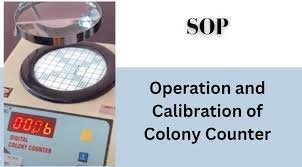SOP for Operating Procedure of Colony Counter

Standard Operating Procedure (SOP) for Operation of Colony Counter
1.0 Purpose
To lay down the procedure for the proper operation of the colony counter for enumeration of microbial colonies on agar plates in order to ensure accuracy and consistency.
2.0 Scope
This SOP is applicable to all microbiology laboratory personnel involved in the operation of the colony counter in the Quality Control (QC) laboratory.
3.0 Responsibility
-
Microbiologist/Analyst: To operate the instrument as per SOP and record results.
-
QC Head/Designee: To review and ensure compliance.
-
Engineering/Service Personnel: For maintenance and calibration, if required.
4.0 Definitions
-
Colony Counter: An instrument used to facilitate counting of microbial colonies on agar plates with the help of magnification and digital/manual counters.
5.0 Procedure
5.1 Pre-Checks
-
Ensure that the instrument is clean and free from dust.
-
Verify calibration status of the colony counter.
-
Check power supply and ensure proper functioning of the digital counter/display.
-
Ensure adequate lighting (white light or LED as available).
5.2 Operation
-
Switch ON the colony counter using the main power switch.
-
Place the agar plate (inverted lid down) on the colony counter stage.
-
Adjust the magnifying lens (if available) for clear visibility of colonies.
-
Use the light source for better contrast of colonies.
-
Count colonies by pressing the marker pen or using the digital counter button for each colony observed.
-
If the model supports it, record counts directly on the digital display.
-
Cross-check the counted value with manual observations if required.
-
Record the results in the respective test worksheet or logbook.
5.3 Post-Operation
-
Switch OFF the colony counter after use.
-
Clean the stage and magnifying glass with lint-free cloth and 70% IPA.
-
Cover the instrument with a dust cover.
6.0 Precautions
-
Avoid applying excessive pressure on plates while counting.
-
Do not use the counter with wet or condensation-rich plates.
-
Ensure colonies are distinguishable; if confluent, record as “TFTC” (Too Few To Count) or “TNTC” (Too Numerous To Count) as per protocol.
7.0 Documentation
-
Record usage details in the instrument logbook.
-
Note down colony counts in the microbiology worksheet.
8.0 References
-
USP <61>, <62>
-
EP 2.6.12
-
Laboratory Instrument Manuals
🎓 Discover one of the best Pharmaceutical Microbiology course available —click below to explore the course that’s shaping future Microbiology course skills.

